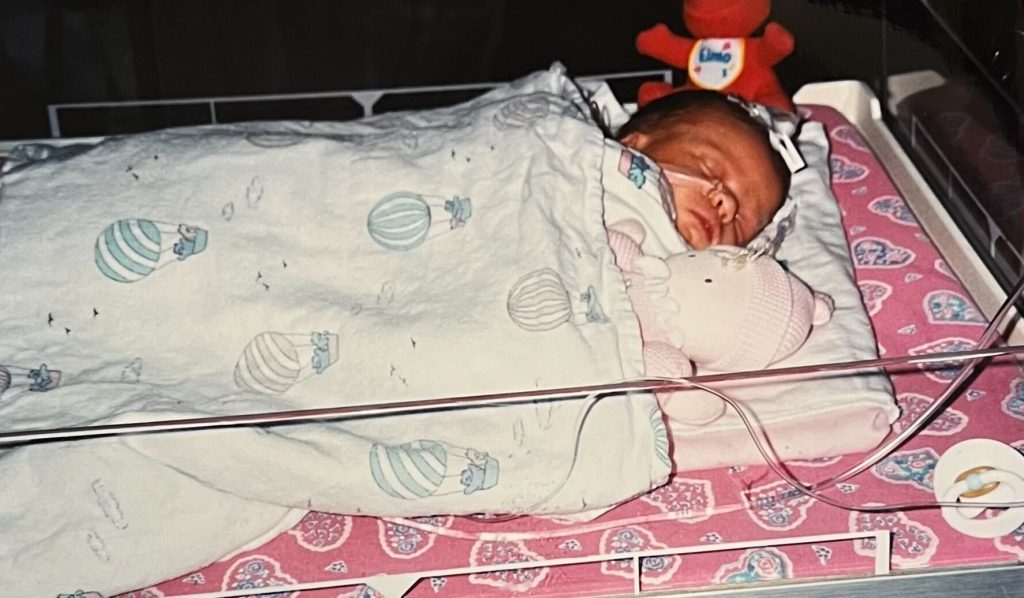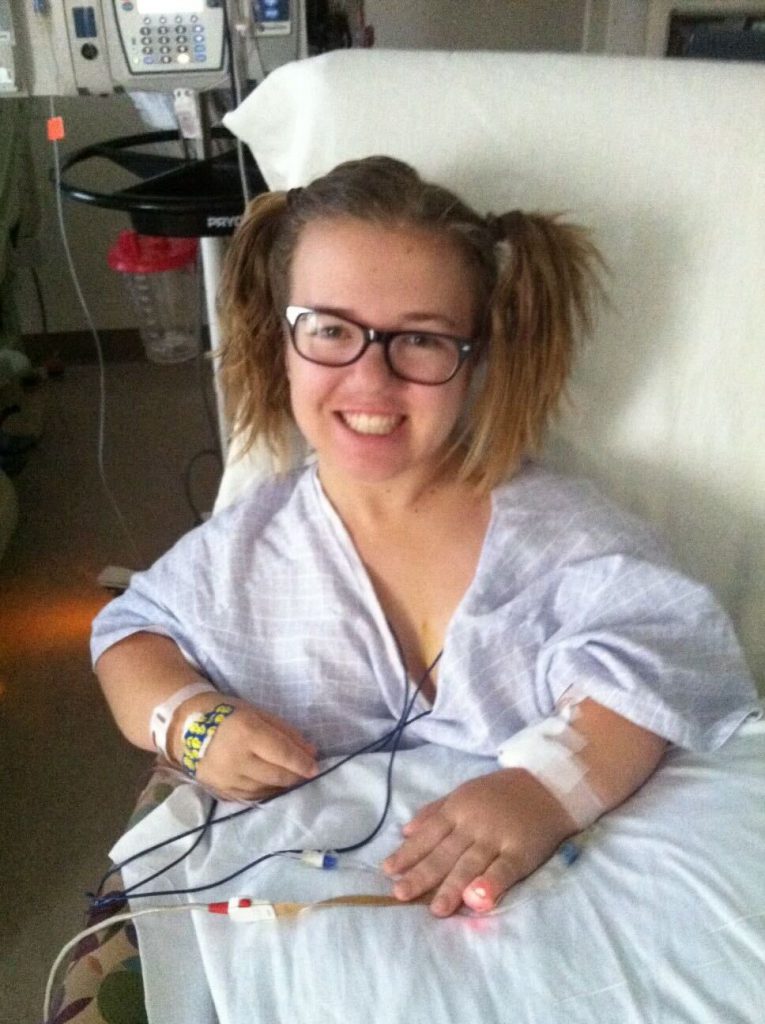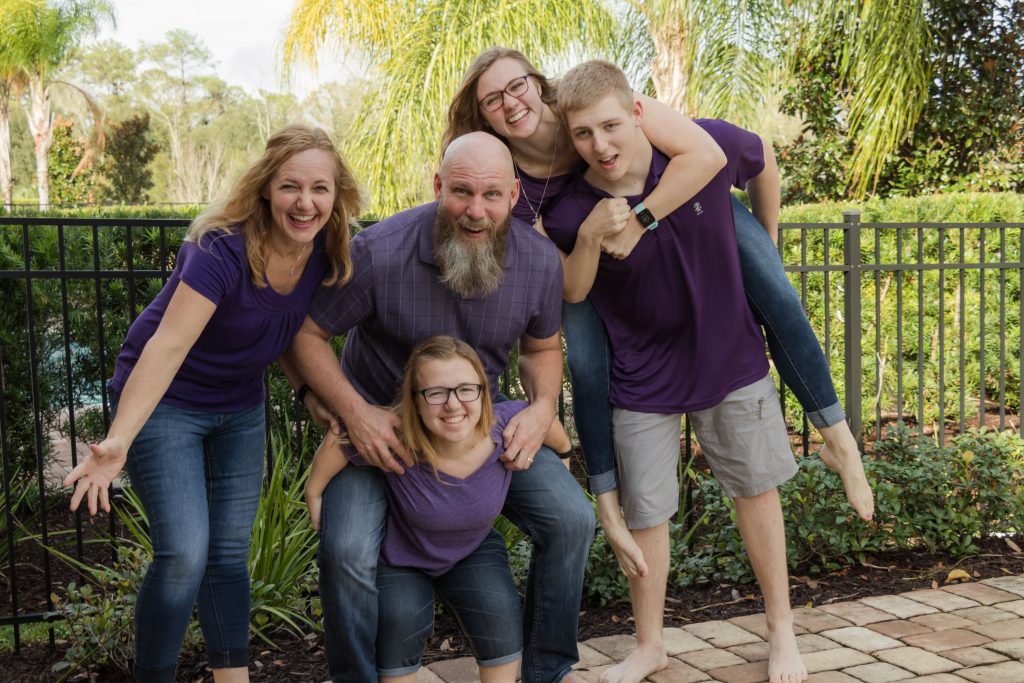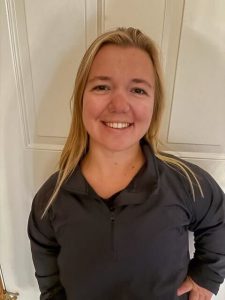Calista loves the simple things in life — going for walks, swimming and, most importantly, being with her friends and family. The simple things are all she needs after the unexpected turns her life has taken throughout her 25 years of life.
Calista’s birth
The unexpectedness of Calista’s life started when she was born in 1999. Without knowing prior to her birth, Calista was born with achondroplasia, meaning she was born a little person. During pregnancy, everything was thought to be normal and there was no family history of achondroplasia, so this came as a surprise.

An hour after being born, Calista was airlifted to Children’s Minnesota to get the expert care she needed. With achondroplasia, your body develops and grows differently, which often requires special medical intervention. At only 6 months old, Calista had her first surgery. Her care team needed to remove a small piece of her skull to give her brain more room to grow.
But Calista’s surgeries didn’t stop there.
Calista’s surgeries
Calista was in and out of the Children’s Minnesota Pediatric Ear, Nose and Throat (ENT) clinic throughout her young life and had five total surgeries by the time she was only 4 years old. Her surgeries included multiple sets of ear tubes, removing her adenoids and taking her tonsils out.
When Calista was a sophomore in high school at age 16, everything in her life changed, again.
She had a perfectly normal day at school but when she got home, she was experiencing some head pain. Trying to sleep it off, Calista went to bed. Her parents checked on her throughout the night but when the morning came, Calista wasn’t awake to get ready for school like normal. Her mom went to check on her and found Calista unresponsive.
Calista’s bleeding on the brain
Calista’s parents called 9-1-1 and an ambulance brought her to a local emergency room (ER) near their home in Buffalo, Minnesota. The ER found that Calista had bleeding on the brain. The ER helped stabilize Calista and then transferred her to Children’s Minnesota via ambulance.
In April 2015, Calista’s care team consisted of a collaborative group of neurosurgery experts from Children’s Minnesota, including Dr. Mahmoud Nagib, who is a pediatric neurosurgeon. In order to stop the bleeding, Dr. Nagib rushed her into surgery for a craniotomy. The surgery was successful!
She spent the next 18 days in the hospital recovering from surgery, where she always had sunglasses and a hat in hand no matter where she went. Calista did physical therapy (PT), occupational therapy (OT) and speech therapy during her recovery. She also needed a shunt placed in her brain in order to help the fluid buildup.
“The biggest thing I learned is that recovery takes time,” Calista said. “During it, it felt like it went on forever. It won’t be as fast as you want it to be.”

While Calista was successful with her PT and OT, she was still struggling with her memory and speech. It was common for her to forget things. For example, her parents were there by her side through it all, but Calista often wondered where they had been.
After those 18 days, Calista was stable and strong enough to go home. She would need to continue her PT, OT and speech therapy as an outpatient.
Continued care
However, Calista’s healing journey was long from over.
In August 2015, she came back to Children’s Minnesota because she was still having head pain. Dr. Nagib and the neurosurgery team at Children’s Minnesota, including Therese Stussy, CNRN, and Peter Clarine, APRN, CNP, decided to remove the shunt in her head to see if it would help with the pain. Unfortunately, her cerebral fluids stayed high. So, seven days later she needed the shunt placed again to drain the fluid buildup she was experiencing.
During her return to Children’s Minnesota in August, Calista was able to re-meet a lot of her care team that tended to her during her stay in April 2015. Even though Calista remembers very little from her time at Children’s Minnesota in April, through her charts, documents and her family’s CaringBridge, she was able to learn more about it. “Even though I remember very little, every single individual took amazing care of me.”
After over a year of still feeling the effects of her initial injury, Calista was back at Children’s Minnesota. In order to help relieve the pressure in her head and get her back to her energetic self, her care team decided to clamp off the shunt so it would no longer be in use. This helped her pain tremendously.
Life after the brain bleed
Calista had a long recovery from her brain bleed. She struggled when she went back to school as learning proved to be difficult. “I looked fine, but nothing was the same,” described Calista.
Trying to heal and go back to school was tiring. In order to get through the school day, Calista would have to take two breaks to lay down and rest. “I was exhausted,” she said.
Still today, Calista struggles with her short-term memory. She also has no peripheral vision above her eyes, and oftentimes puts her hand above her head to protect it.
Mental health struggles
She also struggled with anxiety and depression during her recovery time. “The thing I would say about mental health is make sure you have love and support,” said Calista. “I say that because my family pushed me when I had no motivation.”
When asked if she had advice for other kids or teens struggling with their mental health after a health complication, she said, “Don’t push yourself when you are not ready. Nearly nine years after the injury, I now have a talking therapist because I know that I couldn’t just deal with everything on my own.”

And, even if your recovery time takes longer than you expect, stay strong. Calista says, “Everyone is different. That might be frustrating to hear but, in the end, it helped me be more patient with myself. It’s never going to be easy.”
Calista today
Calista has spent a large part of her life as a patient. Because she knows what it’s like to be a patient, she has a unique gift. Today, she is using that gift in her career.
Calista works as a patient services representative where she can interact with patients and families and help them through their medical journeys. “My life experiences lead me to work with patients,” Calista said. “I love connecting with people.”
Calista is so thankful for her life today and for all the expert care she received at Children’s Minnesota.
“The neurosurgery team at Children’s Minnesota has greatly affected me,” said Calista. “I’m aging out soon but if I could stay at Children’s Minnesota for life, I would.”

And in the end, Calista is grateful for the unexpected.
“Through all of this, I realized I’m a very strong individual,” said Calista. “In the end, I learned the best things that happened to me are the unexpected things. I wouldn’t change a thing.”
You can follow Calista’s journey through her Instagram account.
Celebrating a century of care: Children’s Minnesota turns 100
Children’s Minnesota has been here for 100 years. And it’s all because of you: the people who bring your kids here, the ones who work here, the partners who refer their young patients for specialty treatment, the donors who support us, and the community who rallies around the families in our hospitals. Join us in celebrating a century of care — and a bright, healthy future for Minnesota kids.